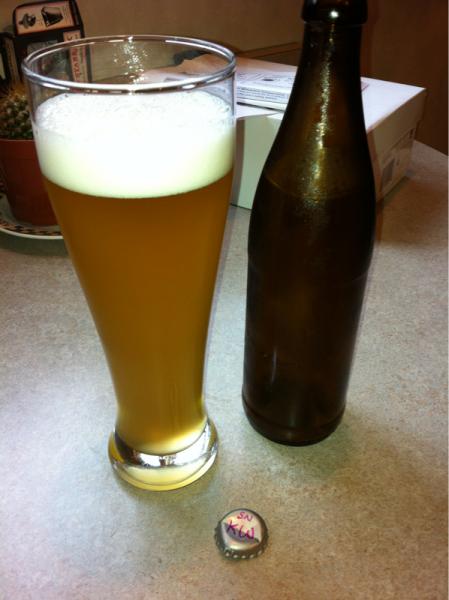mcbethenstein
Well-Known Member
I have been perfecting and tweaking my Weiss for the last year. And although I have a great Weiss, it is missing something. I have been soley using wlp300/wyeast 3068 in my recipe, and I've tried many different fermentations but can't seem to get that clove punch that I want! I've also been battling sulfur that tastes like shrimpy pond water. What I've learned is that too much protein rest= excessive sulphur formation & yes, thinner beer. I have been using acid malt, and I think that my final product is a little too acidic, as I can't seem to get that round, slightly sweet wheat mouthfeel that the commercial examples have. Mine has too much citrus tone to it with the acid. What I think I will be doing, is brewing up a 2 1/2 gal batch, and splitting into 4 glass cookie jars. (I use these for yeast propagation, since I can't seem to keep an erylenmeyer flask intact for more than a week!) Into each container I will pitch 38 billion cells of 4 different yeasts. (pitch rate of 16 mil per ml) Will ferment starting at 60 and raising to 64 with swamp cooler and fish tank heater, and finishing out at 68. Since it will be easier to measure out 1/3 of a vial than a smack pack I'll be testing out WLP 300, WLP 351, WLP 380 and cultured kellerweiss.
I understand that there are many variables in producing the flavors I desire, my hope is that this thread will help myself and other brewers zero in on the factors that will help them get what they want from their yeast. For the purposes of this thread, I would like anyone who has experience with hefe yeasts to list their results. Please include yeast brand, mash rests used with times, OG, pitch rate (how much yeast/batch size), pitching temp, aeration info, fermentation temp profile, vessel info (open or closed), finishing info, flavor notes. Include how the ester/phenol changed with time.
I'll start:
Brew date: 12/29/11
Yeast: Wyeast 3068
Mash profile: 113* for 15 min, 122* for 15 min, 128* for 15 min, double decoction for sacc rests, 75 min boil
OG: 1.047
Pitch rate: 1 L starter into 5.5 gal
FV: plastic bucket, closed with 3 piece airlock
Pitching temp: 67*
Aeration: 48 sec O2 through 2 micron stone
Fermentation profile: put fermenter into swamp cooler after pitching, it dropped to 54* by the next morning. Switched out warm water to bring temp up, settled around 60-61* for main part of fermentation. Brought upstairs and it got to 64* to help decrease the sulphur.
Finishing: kegged and purged with CO2 to reduce sulphur. On tap at 3.0 volumes.
Flavor: huge sulphur! After yeast settled and conditioned sulphur subsided. Banana and clove subdued, but balanced. Slight citrus twang.
Please do not post theoretical information that you have not backed up with actual results. I'm hoping we can prove/disprove the "common" hefe advice. We all know it, but it may not be as simple as ferment warm for banana, ferment cold for cloves. What I've been researching/ reading lately is that you under pitch to accent banana (6 mil/ml), pitch adequately (12 mil/ml) for balance and over pitch (14-18 mil/ml) for cloves, then use temperature to control intensity. Warmer = more flavor compounds, but higher risk of off flavors, and colder = subdued and cleaner ferment, while still having the esters and phenols that the pitch rate would determine.
I will post more as I look through my notes and as my experiments progress.
I understand that there are many variables in producing the flavors I desire, my hope is that this thread will help myself and other brewers zero in on the factors that will help them get what they want from their yeast. For the purposes of this thread, I would like anyone who has experience with hefe yeasts to list their results. Please include yeast brand, mash rests used with times, OG, pitch rate (how much yeast/batch size), pitching temp, aeration info, fermentation temp profile, vessel info (open or closed), finishing info, flavor notes. Include how the ester/phenol changed with time.
I'll start:
Brew date: 12/29/11
Yeast: Wyeast 3068
Mash profile: 113* for 15 min, 122* for 15 min, 128* for 15 min, double decoction for sacc rests, 75 min boil
OG: 1.047
Pitch rate: 1 L starter into 5.5 gal
FV: plastic bucket, closed with 3 piece airlock
Pitching temp: 67*
Aeration: 48 sec O2 through 2 micron stone
Fermentation profile: put fermenter into swamp cooler after pitching, it dropped to 54* by the next morning. Switched out warm water to bring temp up, settled around 60-61* for main part of fermentation. Brought upstairs and it got to 64* to help decrease the sulphur.
Finishing: kegged and purged with CO2 to reduce sulphur. On tap at 3.0 volumes.
Flavor: huge sulphur! After yeast settled and conditioned sulphur subsided. Banana and clove subdued, but balanced. Slight citrus twang.
Please do not post theoretical information that you have not backed up with actual results. I'm hoping we can prove/disprove the "common" hefe advice. We all know it, but it may not be as simple as ferment warm for banana, ferment cold for cloves. What I've been researching/ reading lately is that you under pitch to accent banana (6 mil/ml), pitch adequately (12 mil/ml) for balance and over pitch (14-18 mil/ml) for cloves, then use temperature to control intensity. Warmer = more flavor compounds, but higher risk of off flavors, and colder = subdued and cleaner ferment, while still having the esters and phenols that the pitch rate would determine.
I will post more as I look through my notes and as my experiments progress.








